Replanting primary forests?!?
The innovative method of the Japanese botanist Akira Miyawaki also wins a great success in Europe for planting trees! Inspired by the natural ecosystem of a primary forest, his technique of implantation of ‘ potential natural vegetation ‘ has been applied to many projects around the world!
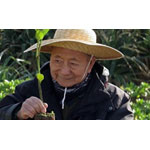
The Miyawaki method aims to mimic the natural ecosystem of a primitive forest!
A reforestation in the ecological’s way!
Some notions about forest ecology:
A primary forest is the result of a vegetation dynamics that naturally occurs over a period as variable as 150 to more than 500 years (depending on ecological conditions).
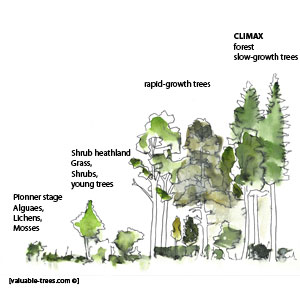 In a non-human-impacted environment, different plant associations install themselves according to a spontaneous transformation of nature. And, the vegetation arrives at natural maturity, in equilibrium with the conditions of the environment. This step is called the climax [learn more about this term].
In a non-human-impacted environment, different plant associations install themselves according to a spontaneous transformation of nature. And, the vegetation arrives at natural maturity, in equilibrium with the conditions of the environment. This step is called the climax [learn more about this term].
In temperate regions, the climax is most often a forest. In the forest, various type of vegetation will install : pioneer trees (heliophiles, rapid growth and short-lived), post-pioneers and Dryads (sciaphiles, slow growth and long-lived).
What about the Akira Miyawaki method?
Expert in plant ecology, Akira Miyawaki specialized in the study of seeds and naturalness of forests. As a distinguished professor at the University of Yokohama, he was rewarded in 2006 by the Blue Planet Award. [Read more about Akira Miyawaki]
Inspired by the natural regeneration of primary forests, the ‘ Miyawaki method ‘ aims at recreating a native forest from native local plants.
A pioneer in ecology, Akira Miyawaki got involved in restoring primitive forests, recreating a ‘ climax ‘. Without going through all the long stages of plant succession, the native forest is thus reconstituted and installed much faster! This ‘ creative ecology ‘, as he called it, has been applied even on highly degraded soils in urban or peri-urban areas.
The purpose of these forests is very different from conventional methods, such as:
–forestry for the production of wood: planting in monoculture of conifers or exotic species with rapid growth.
–ornamental planting from varietal or transformed selection (grafting, cloning) produced in horticulture. These trees that often originate from cloning do not have a genetic capital sufficiently diversified to be resilient to face climatic or pathogenic hazards.
The intention is to create multilayered and resilient forests for the survival of the environment!
The aim is to create a green lung within the cities or to reforest rural areas, by re-planting formerly native species.
Originally conceived with the intention of reforesting Japan, the Miyawaki method has been applied to the regeneration of tropical forests. Reforestation according to this principle was carried out in Asia (Japan, China, Malaysia, Thailand, Cambodia), South America (Brazil), India, Africa (Kenya) and Europe.
What is the Miyawaki method?
Many reforestation projects created according to this method around the world explain that the Miyawaki forest offers:
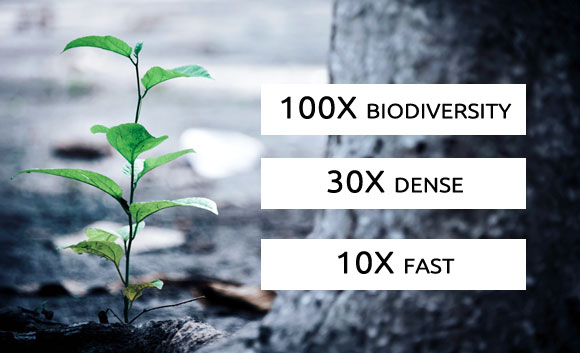
= > Biodiversity, phytosociology and community of plants
The idea is to recreate a rich forest ecosystem by reproducing the native low shrub and tree stratum!
Biodiversity is implanted through a mixture of species from natural seeds in a very dense and random plantation. Phytosociology and naturalness are at the heart of this environmentally friendly method. The symbiosis between plants and natural selection of plants best adapted to an area and climate is done spontaneously. The soil and micro organisms are also restored.
= > Rapid growth for a resilient and sustainable ecosystem
It’s about planting very young trees!
Only trees in the ‘juvenile’ development phase and without any transplant have the ability to grow according to their own nature and adapt to a unique environment. In this way, they put in place the right survival strategy in the face of the environment in which they find themselves.
Biodiversity, genetic diversity and natural adaptation ensure the resilience of vegetation to climate challenges!
= > A plantation without regular maintenance
Here is a forest that does not require maintenance beyond the first years of installation. The ecosystem is regenerating spontaneously.
 This method seems to us to be of interest in the face of global warming!
This method seems to us to be of interest in the face of global warming!
A long-term follow-up of natural selection by climatic zone could be of the highest interest to follow the evolution of trees in the face of climate change!
Indeed, the very rapid climatic changes produced by the human activity of this last century make it difficult to predict the genetic mutation of trees.
Scientists are working on the recognition of essences with a ‘ phenotypic plasticity ‘ i.e. that can withstand very large temperature disparities. [Learn more about this term].
It is currently difficult to predict the genetic adaptation (mutation) of trees. Biodiversity and the planting of varieties with different genes will allow the natural evolution of trees.
On an experimental basis in anticipation of global warming, the planting of drought-resistant species in the North of the country is also topical. Indeed, the migration capacities of the trees from North to South in the face of global warming, in this short period of time are hardly foreseeable.
Indeed, INRA has already identified, in the Mediterranean region, species which are non-invasive, non-allergenic and can withstand urban conditions!


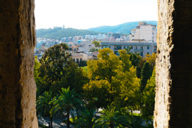


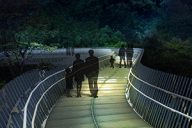

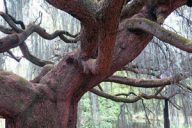
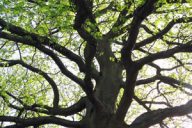
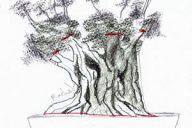
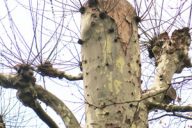
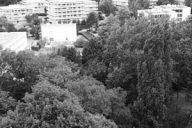
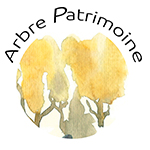 (33)07 60 50 08 70
(33)07 60 50 08 70






